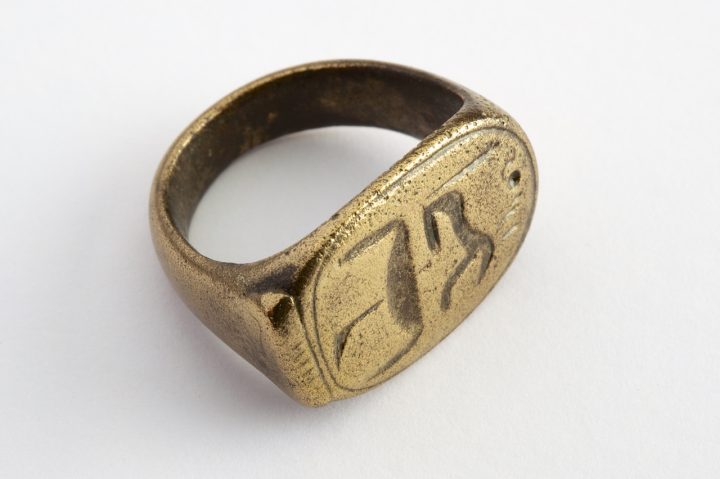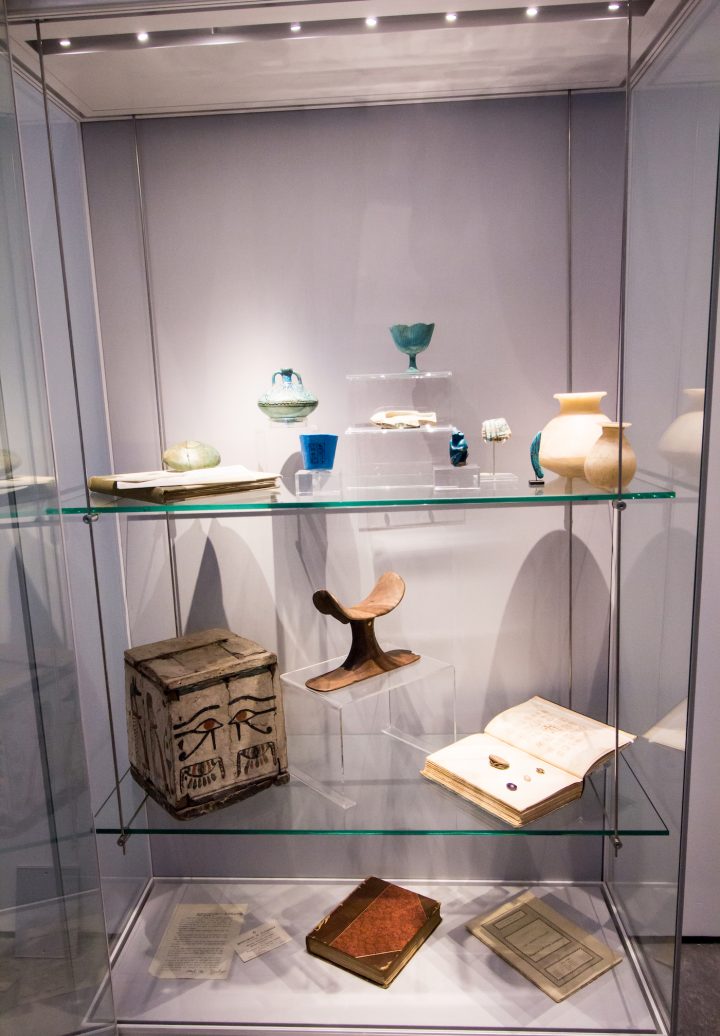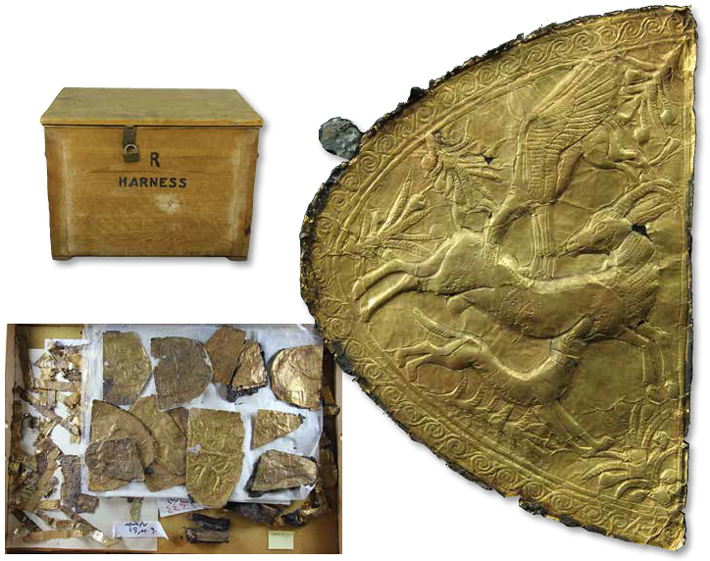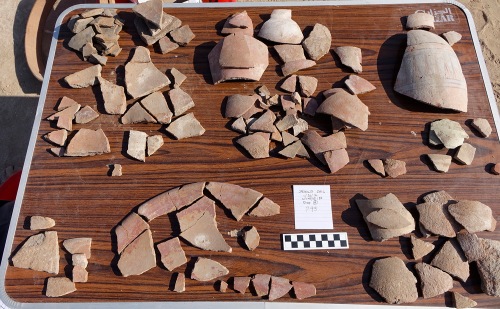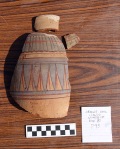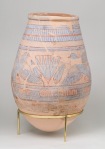http://nilescribes.org/2018/02/24/lecture-maces-and-daggers-from-the-roms-egyptian-collection/ The Nile Scribes are pleased to host another guest blogger on our site to give us a summary of her research on Egyptian weapons at the Royal Ontario Museum. Carla Mesa Guzzo presented some of her findings at a talk in January of this year for the Toronto Chapter of the SSEA.
Guest Scribe: Carla Mesa Guzzo
The Egyptian collections at the Royal Ontario Museum (ROM) encompass everything from objects of daily use to mummies and coffins to relief fragments. Among these are some 25,000 accessioned objects, about 2,000 of which can be viewed in the Egypt and Nubia galleries. There are a variety of Egyptian weapons, including maces and daggers. These objects have complex histories and a significance that goes beyond simple martial function. Our knowledge, however, is often limited by the more recent histories of these objects and how they came to be in the ROM's collections. In order to understand the ancient origins of these pieces, it is fist necessary to understand the means by which they came to us in the present.
A brief history of the ROM
The Royal Ontario Museum of Archaeology was officially created in 1912, and opened its doors in March of 1914. There are many figures that feature prominently in the establishment and early development of the Royal Ontario Museum, but among them was Charles Trick Currelly, the first director of the museum from 1914-1946. While many individuals have contributed to building the Egypt and Nubia collections over the past century, including through fieldwork, Currelly was particularly active in building the ROM's collections during the early 1900s, while the museum itself was still in the process of being created. He worked at several sites in Egypt, including Deir el-Bahri and Abydos, around the turn of the (last) century. Many items were acquired via excavations as well as through his connection to the Egypt Exploration Fund and to W.M. Flinders Petrie.[1]

Charles Trick Currelly (Photo: Smithsonian Institute Archives)
The ROM's Egyptian Collection
While some of the maces and daggers at the ROM which came to the museum in its early years do come from recorded excavations, a great number of objects were purchased in Egypt by Currelly himself. In the case of a great many of these purchased objects, the exact provenance of a piece is often uncertain or unknown altogether. To a great extent, the significance of an object can only be fully gleaned by considering it in its original context. This, naturally, presents a problem to researchers attempting to understand these objects and limits what we can say with any degree of certainty about the history and meaning of certain pieces.
This lack of recorded provenance is not the only challenge facing researchers interested in the ROM's Egyptian collections. Currelly's work resulted in a very important collection of Egyptian antiquities, which has been highly valuable for many researchers and scholars as well as for the public. However, Currelly and his contemporaries were active within the period of colonial archaeology in Egypt. Because of this, the work, collecting practices, and findings of such individuals and various institutions around the world must be understood in retrospect and with a critical eye as necessarily being informed by the attitudes and the colonialist, Eurocentric approaches of the day. This colonial legacy is still very much alive today, and something with which Egyptologists and museologists alike must continue to grapple, both within the context of the ROM and these disciplines at large. This context has also, unsurprisingly, affected our ability to access the histories of individual objects in the collection, partially because of the aforementioned issues with provenance, but also because it has affected the filter through which we view these objects.
In terms of the weapons themselves, there are roughly 43 maces in total, and around 10 Egyptian daggers or parts thereof in the Royal Ontario Museum's collections. While each is fascinating in its own right, two of these objects are particularly apt for demonstrating the challenges facing researchers, who try to piece together their histories without recorded provenance.
(1) Macehead with depiction of an animal
One of these items is an early predynastic, biconical macehead made of red breccia, probably from Upper Egypt (see image). The figure of a small animal decorates one end. Ciałowicz has suggested that this creature is a scorpion. During the later Predynastic and the Proto/Early Dynastic periods, scorpions are important emblems.[2] They are familiar to us from the early history of Egyptian kingship, either as a name (as in King Scorpion, the figure on the Scorpion macehead) or as "an expression of royal power".[3]

Macehead in the Royal Ontario Museum, Acc. No. 900.2.55 (author's photo)
But representations of scorpions from early Egypt tend to look quite different from the creature on the ROM macehead. They often show rounded segments on the tail, or a greater number of appendages which are placed differently.[4] The assumption that this is a scorpion may in fact be inspired by the much later Scorpion Macehead, resulting in a projection of our own expectations onto an object, based on later circumstances, and regardless of whether or not these expectations actually describe what we can observe.
If we look at representations of animals on predynastic pottery, the closest parallels to what we see on the ROM mace are crocodiles or lizards (according to Jean Capart's identification of these animals).[5] A crocodile would certainly make sense on a weapon as an aggressive, forceful animal. However, that this could be a lizard is important to consider as well. In addition to a strong initial visual resemblance, it should be noted that the figure is carved on the underside of the macehead (i.e. the side of the mace bearing the larger end of the perforation).[6] This seems to indicate that this creature is a lizard rather than a crocodile, since this may be a reference to the ability of some lizards to walk vertically and upside-down.
The symbolism of the macehead
But if this is the correct interpretation, it still does not really tell us why such an image would be carved on a weapon. In a period where we lack any form of written record, it is nearly impossible to say what the meaning of a lizard (or crocodile) on a macehead could be. Ultimately, this image could be anything from a personal marker, to a magical or apotropaic symbol. It is difficult, even, to rely on the significance of these animals in the historical period for answers, since this meaning may have changed drastically over such a vast span of time. Any answers to this question that may have been provided by considering the mace in its original context, whatever that may have been, have been lost.
(2) Dagger of Ahmose

Dagger bearing the name of Ahmose in Royal Ontario Museum, Acc. No. 909.97.2 (Photo: ROM)
Similarly, most of the daggers at the Royal Ontario Museum are listed as having been bought by C.T. Currelly and are lacking in concrete provenance. The particularly vexing nature of this piece is not due to uncertain authenticity, but rather uncertain context and meaning. This is a dagger with bronze blade, ebony handle, and a stone pommel bearing a gold plaque with the throne name of Ahmose, founder of the New Kingdom. It also contains several other decorative elements in gold. The finely crafted nature of the piece, in conjunction with the fact that it bears a royal name, might seem like a straightforward case for seeing this as something owned by Ahmose himself.
Indeed Currelly seems to have thought so.[7] In his autobiography, Currelly tells us how he acquired the dagger:
"…a dealer whom I knew was sitting on the bank waiting for me. He had several things to sell, but what made my eyes pop was that one of them was the sword of Aahmes [i.e. Ahmose]. It was a beautifully made bronze sword, with a gold and ebony handle and an alabaster pommel with Aahmes' name on a gold plate, fastened to the alabaster. The dealer told me that it had been found in a tomb, in a certain place which I knew was not far from where Aahmes had been buried. My guess was that it had been stolen from the king's tomb when his body was removed, and buried in the tomb of the thief."
The dagger as a military reward
Currelly's assumptions may be correct. But royal weapons are not the only ones that could bear a royal name. According to Sonya Foke, this kind of assumption is made with weapons bearing royal names in general.[8] However in many cases with a known provenance, the item actually comes from a private context and should be seen, as Foke argues, as a reward granted by the king to private individuals for, e.g. military service.[9]

Pommel bearing the name of Ahmose on dagger in Royal Ontario Museum, Acc. No. 909.97.2, close-up (author's photo)
An alternate explanation for this dagger, then, is that it was, in fact, given as a reward and that the tomb in which it was reportedly found was that of its original owner. But even if this is not a royal dagger, the significance of this piece is not lessened, but rather changed. The history of this dagger speaks more to the relationship between the king and his military officers. This alternate version of events does, however, serve to further illustrate the pitfalls researchers may face when dealing with objects without a secure provenance. The recent history of the ROM's Ahmose dagger highlights the uncertainty that can be faced when approaching the ancient origins such objects, as well as demonstrating the potential dangers of assigning meaning without considering all possibilities for the origins of a piece.
Carla Mesa Guzzo is a PhD candidate in the department of Near and Middle Eastern Civilizations at the University of Toronto. During the course of her volunteer work at the Royal Ontario Museum, she has researched and catalogued a variety of objects from ancient Egyptian games to Meroitic glass. Her primary focus, however, has been on the ancient Egyptian weaponry in the ROM's collections.
Notes
[1] More abut the ROM's history can be found on the Royal Ontario Musum's website and in Lovat Dickson's The Museum makers: The Story of the Royal Ontario Museum. Toronto: Royal Ontario Museum, 1986.
[2] See Krzysztof M. Calowicz, Les Têtes de massues des périodes prédynastique et archaïque dans la Valée du Nil. Warszawa: Państwowe Wydawnictwa Naukowe, 1987. p. 27
[3] From Toby A. H. Wilkinson, "What a King is This: Narmer and the Concept of the Ruler" Journal of Egyptian Archaeology 86. (2000): 23-32.
[4] E.g. see Jean Capart, Primitive Art in Ancient Egypt. London: H. Grevel & Co., 1905. p. 222, fig. 97
[5] E.g. see Jean Capart, Primitive Art in Ancient Egypt. London: H. Grevel & Co., 1905. p. 122. fig. 96-97
[6] Also noted by Dr Steven Shubert.
[7] C.T. Curelly. I Brought the Ages Home. Oxford: Oxford University Press, 2008. p. 56.
[8] Sonia Foke in "'His Majesty Saw My Valour': Weapons as Rewards for Feats on the Battlefield." Warfare and Society in the Ancient Eastern Mediterranean: Papers Arising from a Colloquium Held at the University of Liverpool, 13th June 2008. Eds. Stephen O'Brian and Daniel Boatright. Oxford: Archaeopress, 2013. 5-18.
[9] ibid.
-- Sent from my Linux system.

























